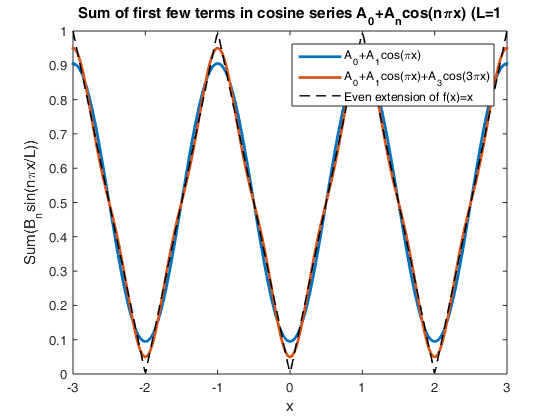Fourier cosine series: triangular wave
Math 331, Fall 2017, Lecture 2, (c) Victor Matveev
Fourier cosine series of a simple linear function f(x)=x converges to an even periodic extension of f(x)=x, which is a traingular wave. Note the very fast convergence, compared to the sine series
clear; hold off L = 1; % Length of the interval x = linspace(-3*L, 3*L, 300); % Create 300 points on the interval [-3L, 3L] Const = -4*L/pi^2; % Constant in the expression for A_n Cn = L / 2; % The baseline of the cosine series: A0 = L/2 for n = 1 : 2 : 3 % Only sum over odd integers An = Const/n^2; % Coefficients inversely proportional to n^2 Fn = An * cos(n*pi*x/L); % Calculate Fourier cosine term Cn = Cn + Fn; % Add the term to Fourier cosine series sum plot(x, Cn, 'linewidth', 2); % Plot the cosine fourier sum hold on; end xlabel('x'); ylabel('Sum(B_nsin(n\pix/L))'); title('Sum of first few terms in cosine series A_0+A_ncos(n\pix) (L=1'); plot(x, abs(mod(x+1,2)-1), 'k--', 'linewidth', 1); % Trickiest part of the code: create triagular wave legend('A_0+A_1cos(\pix)', 'A_0+A_1cos(\pix)+A_3cos(3\pix)', 'Even extension of f(x)=x');
